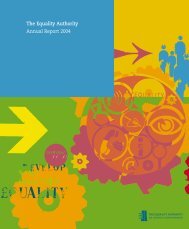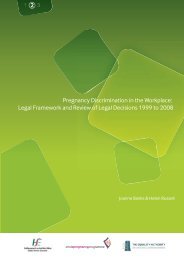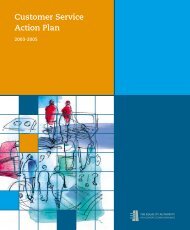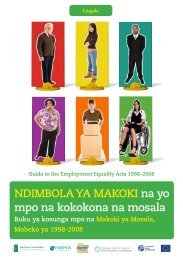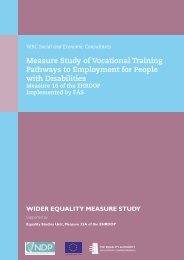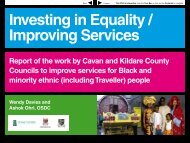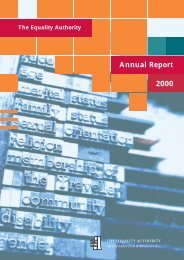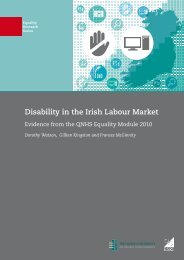Pregnancy and Employment: A Literature Review - Crisis Pregnancy ...
Pregnancy and Employment: A Literature Review - Crisis Pregnancy ...
Pregnancy and Employment: A Literature Review - Crisis Pregnancy ...
Create successful ePaper yourself
Turn your PDF publications into a flip-book with our unique Google optimized e-Paper software.
<strong>Pregnancy</strong> <strong>and</strong> <strong>Employment</strong>: A <strong>Literature</strong> <strong>Review</strong><br />
While having pre-school age children did not significantly alter the risk of downward mobility attached to shifts to<br />
part-time work, Connolly <strong>and</strong> Gregory (2008) did find that the (lack of) availability of part-time opportunities in the<br />
previous employment strongly influenced the chance of downgrading.<br />
It should be noted that the polarisation between part-time workers <strong>and</strong> full-time workers is particularly acute in the<br />
UK <strong>and</strong> so the results might be stronger than in other societies (Gornick & Meyers, 2003; McGinnity <strong>and</strong> McManus,<br />
2007; O’Reilly <strong>and</strong> Fagan, 1998).<br />
The literature on occupational downgrading highlights that returning to the pre-birth employer is a decisive factor<br />
in avoiding occupational downgrading on return to work, particularly for mothers who wish to reduce their work<br />
hours. The availability of job protected leave is crucial for women to maintain this link with their previous employer.<br />
While all EU countries provide a minimum of 14 weeks paid leave with job protection, there is wide variation in<br />
the maximum period of job-protected leave (see Banks & Russell, 2011). <strong>Employment</strong> practices, particularly the<br />
availability of reduced or part-time hours, are also likely to influence women’s likelihood of remaining with their<br />
pre-birth employer. Where an employer does not provide such flexibility women may be pushed into a job move<br />
despite an entitlement to return to their previous employment. The evidence in the UK shows that such moves<br />
may be extremely costly in terms of occupational downgrading. In the following section we examine a very similar<br />
set of issues in relation to women’s pay levels.<br />
4.3 The Motherhood Pay Penalty<br />
In this section of the review, we describe studies that have investigated the effect of childbirth on women’s<br />
subsequent earnings. We use the term motherhood pay penalty to encompass the pay disadvantage that women<br />
experience as a result of interrupting their careers to have children <strong>and</strong> the gap in pay that this leads to, both<br />
between women <strong>and</strong> men, <strong>and</strong> between mothers <strong>and</strong> non-mothers (when other relevant characteristics have<br />
been held constant).<br />
Numerous studies have demonstrated that time out of the labour market has a negative impact on women’s<br />
earnings across a wide selection of countries (Stafford & Sundstrum, 1996, in Sweden; Mincer & Ofek, 1982, in<br />
the US; Wetzels & Tijdens, 2002, in the Netherl<strong>and</strong>s; Beblo & Wolf, 2002, in Germany). Various studies have also<br />
demonstrated that differences in length of labour market experience <strong>and</strong> time out of employment account for<br />
a significant part of the male-female wage gap (Albrecht et al, 1999; Barrett et al, 2000; Callan & Russell, 2003;<br />
McGuinness et al, 2009; Waldfogel, 1997a).<br />
We begin with the Irish studies. The most recent analysis of gender differences in pay was carried out by<br />
McGuinness et al (2009), using data from the 2003 National <strong>Employment</strong> Survey. The survey is a matched sample<br />
of employers <strong>and</strong> employees, <strong>and</strong> the number of employees used in the analyses was 38,752. The unadjusted gap<br />
in men <strong>and</strong> women’s hourly wages was 22%. When a wide range of individual <strong>and</strong> organisational characteristics<br />
were controlled for, a gap of 8% remained. The authors found that the difference in the labour-market experience<br />
of men <strong>and</strong> women – which widened the gap by three percentage points, equivalent to 14% of the raw gap –<br />
was the largest single influence on the gender wage gap (McGuinness et al, 2009). This difference in experience<br />
between women <strong>and</strong> men is mainly accounted for by the time women spend looking after family, but is also<br />
contributed to by the younger age profile <strong>and</strong> higher educational qualifications of women in employment. Family<br />
structures account for 10% of the gap in men’s <strong>and</strong> women’s earnings, but marriage rather than children was found<br />
to have the larger impact (2009, p20). The consequences of childbirth <strong>and</strong> childcare on pay are also likely to be<br />
captured in the effects of working part-time, since many women enter part-time work only after they have had<br />
children. Women working part-time are found to earn considerably less than part-time men, even though they<br />
have higher qualifications <strong>and</strong> more employment experience. When these <strong>and</strong> other characteristics are taken into<br />
account, there is a 10% gender pay gap among part-time workers. Moreover, part-timers are also found to earn<br />
significantly less than similarly qualified full-time workers, <strong>and</strong> women’s greater concentration in part-time work<br />
contributes to the gender pay gap (ibid, p20).<br />
Similar results emerged from earlier Irish studies. Using data on earnings for 1997 38 , Barrett et al (2000) found the<br />
unadjusted gap in men’s <strong>and</strong> women’s earnings was 20% <strong>and</strong> that years out of the labour market accounted for<br />
38 The data come from the Living in Irel<strong>and</strong> Survey.<br />
PAGE 42




